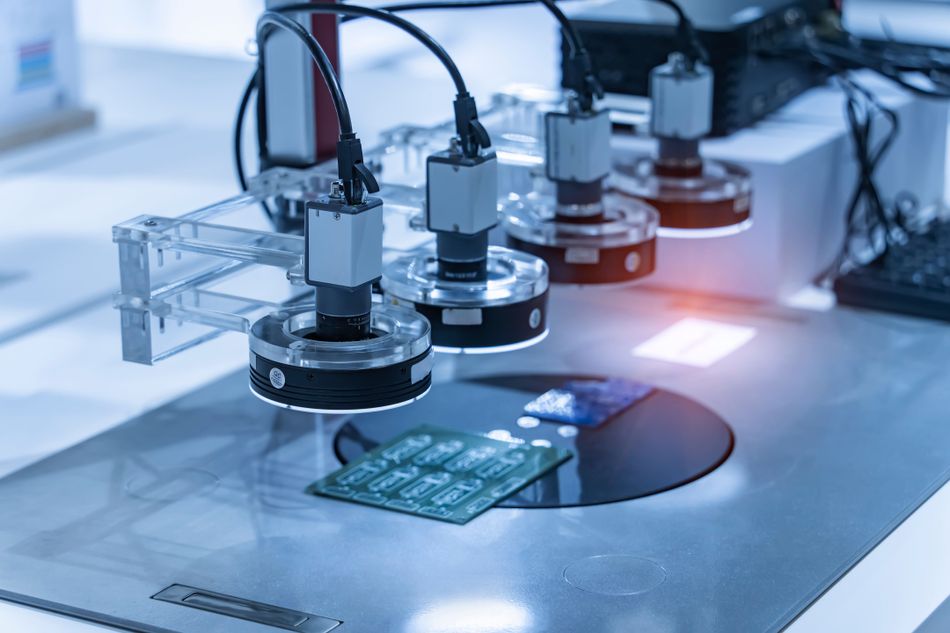The Role of IoT in Robotics and AI: Understanding Connectivity
The integration of AI, IoT, and robotics allows robots to access and exchange data with other devices, enabling them to make informed decisions.
Introduction
In the world of engineering, the integration of the Internet of Things (IoT), robotics, and artificial intelligence (AI) is transforming the capabilities of autonomous systems. This article focuses on the importance of connectivity in enabling robots to access and exchange data, leading to more intelligent and adaptable systems.
IoT allows robots to connect to networks, while robotics involves the design and operation of autonomous machines. AI enhances IoT-enabled robots by analysing data and making informed decisions. Sensor technology, connectivity modules, and AI processing units are key components in this integration.
Understanding IoT, Robotics, and AI
When we talk about integrating IoT devices with robotics and adding a layer of AI in the system, it is necessary to understand the basic differences between AI, IoT, and robotics and how they form a base for IoT-enabled robotics. These three terms are the enablers of advanced robotics, impacting how IoT-enabled robots interact with the environment. For that reason, let's break down these concepts in simple terms.
IoT
The IoT refers to a network of physical objects that are embedded with sensors, software, and other technologies to connect and exchange data with other devices and systems over the internet. This exchange of data expands the possibilities for automation, monitoring, and control. While IoT is primarily focused on connectivity and data exchange, it does not inherently possess autonomous decision-making capabilities.
Robotics
Robotics is the science and technology involved in designing, constructing, and operating robots. Robots are autonomous or semi-autonomous machines that can perform complex tasks, interact with their environment, and manipulate objects. Unlike IoT devices, which primarily focus on connectivity and data exchange, robots are physical entities capable of interacting with the physical world. While some robots may be equipped with IoT capabilities, not all robots are inherently part of the IoT ecosystem.
In robotics, the IoT presents an opportunity for integrating advanced robots into broader networks, enabling them to act in a more intelligent and autonomous manner. The IoT has transformed robotics with the paradigm shift known as Internet of Robotic Things (IoRT).
AI
AI encompasses the development of intelligent systems that can perform tasks requiring human-like intelligence. AI algorithms enable machines to analyse data, identify patterns, make predictions, and even make decisions based on available information. AI augments the capabilities of IoT and robotics by providing advanced data analysis capabilities and enabling autonomous decision-making. While AI can be integrated with IoT devices and robots to enhance their functionality, not all AI systems are directly part of the IoT ecosystem.
The Role of AI in the Convergence of Robotics and IoT
AI is the core of this convergence between robotics and IoT. While IoT provides the mechanism for connecting robots and gathering data, AI is the engine that processes, learns from this data, and enables autonomous decision-making.
For instance, an AI-powered IoT robot could leverage machine learning algorithms to recognize patterns in the data, learn from them, and make predictions or decisions based on its learnings. This combination of IoT connectivity and AI-based learning results in a new breed of intelligent, autonomous robots capable of complex operations without requiring constant human oversight.
However, not all robots are inherently part of the IoT. A robot becomes an IoT device when it's equipped with sensors and connectivity capabilities that allow it to collect, transmit, and receive data over the internet. In essence, it's the ability to participate in the larger, interconnected ecosystem of data and devices that makes a robot an IoT device.
The Mechanics of IoT in Robotics and AI
Three primary technological areas are integral to this interconnected system: sensor technology, connectivity modules, and AI processing units.
Sensor Technology
By combining many sensors—including cameras, radars, lidars, and ultrasonic sensors—designers can create data that is merged into a single model of sensor fusion to create a robust sense function. As the Internet of Vehicles (IoVs) and edge intelligence are used for training and real-time environment models, the sense functions are evolving towards distributed model-based or AI-inference processing at the sense-node and in the central cognition.
The advancement of sensor technology in the IoRT system's capacity to sense the environment using a variety of sensor types, combine the information from the various sensors, and localize itself and other things using GPS/GNSS signals and both local and high-definition maps to create a semantic understanding and local and global models. Because perception information is the input for analytics and AI processing, the data that these sensors acquire must be in a format that can be used by various and unique cognitive processes of robotic things and applications.
Connectivity Modules
Connectivity is the lifeblood of the IoT, facilitated by communication modules that enable data exchange between devices. These modules employ a variety of technologies, including Wi-Fi®, Bluetooth®, Zigbee, LoRaWAN, and cellular networks.
In terms of connectivity, wireless communication methods are dominant for IoRT. When discussing the interactions and pairings of wireless technologies (such as cellular 5G and beyond), IoT/IIoT, and AI approaches and processes, the term "intelligent connectivity" is used.
The connectivity of modules for IoT-enabled robotics involves developing robotic objects with reliable wireless and cellular connectivity is essential. IoRT applications may use wired, wireless, cellular, optical, audio, video, voice, or other types of communication channels. Any of a wide range of protocols—including TCP, UDP, 802.15.1, 802.15.4, 802.11, 4G/LTE/5G—can be used as the foundation for the communication networks.
Edge-distributed processing, including analytics at the edge based on AI concepts and approaches, replaces centralised processing for mission- and safety-critical IoRT applications where latency, dependability, and throughput are crucial requirements. Edge-distributed processing makes use of multi-access edge computing, fog computing, and intelligent connection offered by wireless and cellular communication (4G/5G and beyond). This idea enables IoRT apps to process data locally and use local learning to apply AI algorithms to the data that has been acquired, reducing the need to transport huge volumes of data to the cloud, store data locally, and lighten the stress on connection lines.
AI Processing Units
AI processing units, also known as AI accelerators, constitute the brainpower behind IoT-enabled robots. The progress of IoRT depends heavily on the AI processing units. The capabilities of particular robotic objects are improved by the AI algorithms. To improve cognition and decision-making, AI technologies are used to optimise the sensor fusion capabilities of IoRT devices (such as cameras for detecting sight, chemical sensors for identifying smell and taste, microphones for hearing, pressure sensors for detecting touch/pressure). They are also used to extract patterns from data. To give analytics and insights and to optimise the functions of the individual robotic things and their cooperative behaviours as a fleet, AI techniques and approaches are incorporated in the various layers of IoRT platforms.
Deep neural networks, such as convolutional neural networks (CNNs), are used to assess and extract visual features from images. To improve the performance of the recognition function by attaining high detection rates of quality variations or probable errors, the strategies are created for partitioning and de-noising monitored signals. IoRT applications can now handle extraordinarily huge data sets because of the transition from central compute to edge/fog nodes. To significantly increase the computing efficiency of an inspection model that can identify the type and severity of defects, this method is also used in the case of effective manufacturing inspection systems. It combines AI techniques with edge processing by adapting a CNN model to the fog computing environment.
At the level of robotic things, video capture, video data compression, video picture pre-processing, and segmentation are performed using perception tools like cameras. Better object identification accuracy can be achieved by jointly training a context and scenery-aware adaption model using data from various video capture systems. An ideal offloading method must be established in order to balance the distribution of the deep learning (DL) computation among IoRT devices, edge servers, and the cloud. The trade-offs between important indicators such network health, video compression, data rates/usage, power consumption, processing delay, frame rate, and processing accuracy of analytics must be taken into account. Numerous distributed edge robotic thing devices can work together at the edge to provide better services.
The system's overall performance can be enhanced by edge computing federation and distribution of functions for compressing the DL model at the edge layer. According to a research on object detection in edge computing, the cloud can guarantee the integration of distributed learning models with the edge computing layer and update the parameters of these models on edge devices. The computing power and global knowledge in the cloud infrastructure can be used for processing and assisting the edge nodes in updating DL models when the edge infrastructure is unable to provide a reliable service with the required quality (e.g., detecting objects/patterns with low confidence).
Mouser Electronics, an authorised global distributor of electronic components, offers a wealth of products and knowledge that support the development of IoT-enabled robotics and AI systems.
These products range from advanced microcontrollers and processors to sensors, connectivity modules, power management devices, and much more. By supplying these essential elements, Mouser is facilitating the development and deployment of IoT-enabled robotics and AI systems across various industries.
Conclusion
The integration of the IoT with advanced robotics and AI is revolutionizing the capabilities of autonomous systems. Robots connected to IoT networks gain access to a wealth of data and the ability to communicate and collaborate with other devices, leading to more intelligent and adaptable systems.
The addition of AI further enhances the capabilities of these IoT-enabled robots, enabling them to learn, reason, and make informed decisions based on real-time data analysis. Together, IoT, robotics, and AI are reshaping industries and everyday life, offering new opportunities for innovation and automation.
As engineers and designers embark on the development of IoT-enabled robotics and AI devices, Mouser Electronics serves as a reliable partner, providing the tools to compare and acquire the necessary components for these groundbreaking technologies. Through their comprehensive inventory and user-friendly website, Mouser supports the advancement of IoT-enabled robotics and AI, driving progress and shaping the future of intelligent and autonomous systems.
References:
https://www.frontiersin.org/articles/10.3389/frobt.2020.00104/full
https://geekflare.com/digital-transformation-ai-robots-iot/
https://www.analyticssteps.com/blogs/internet-robotic-things-robotics-iot



